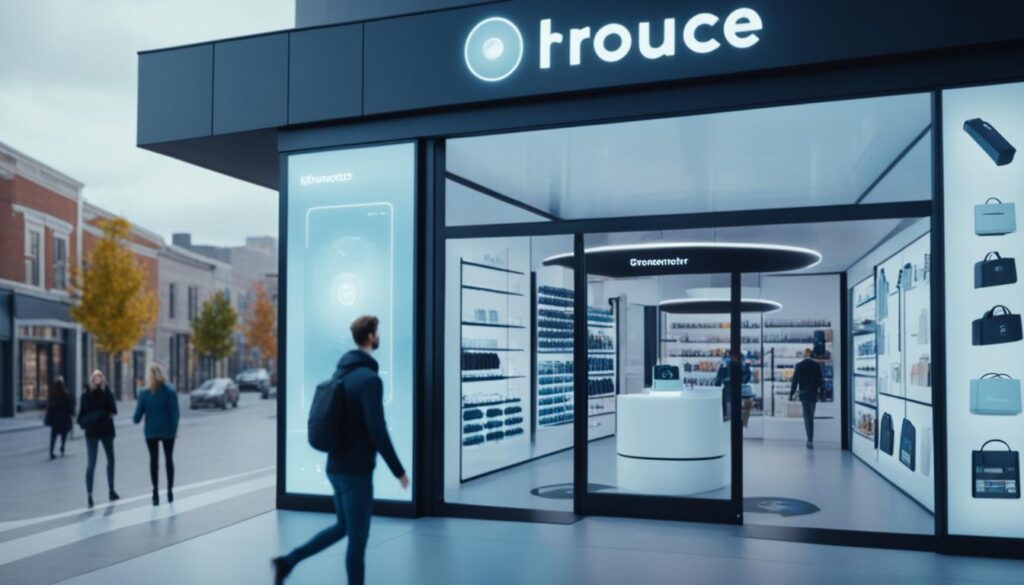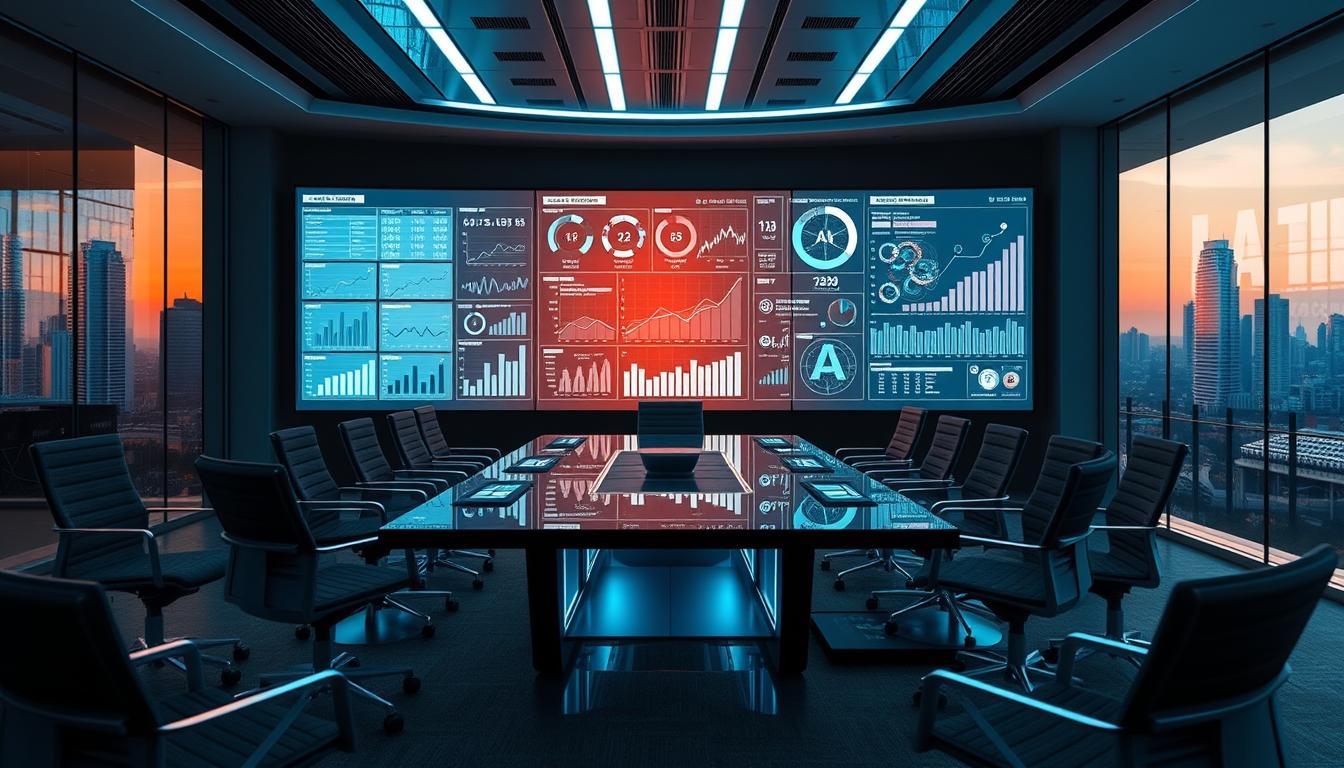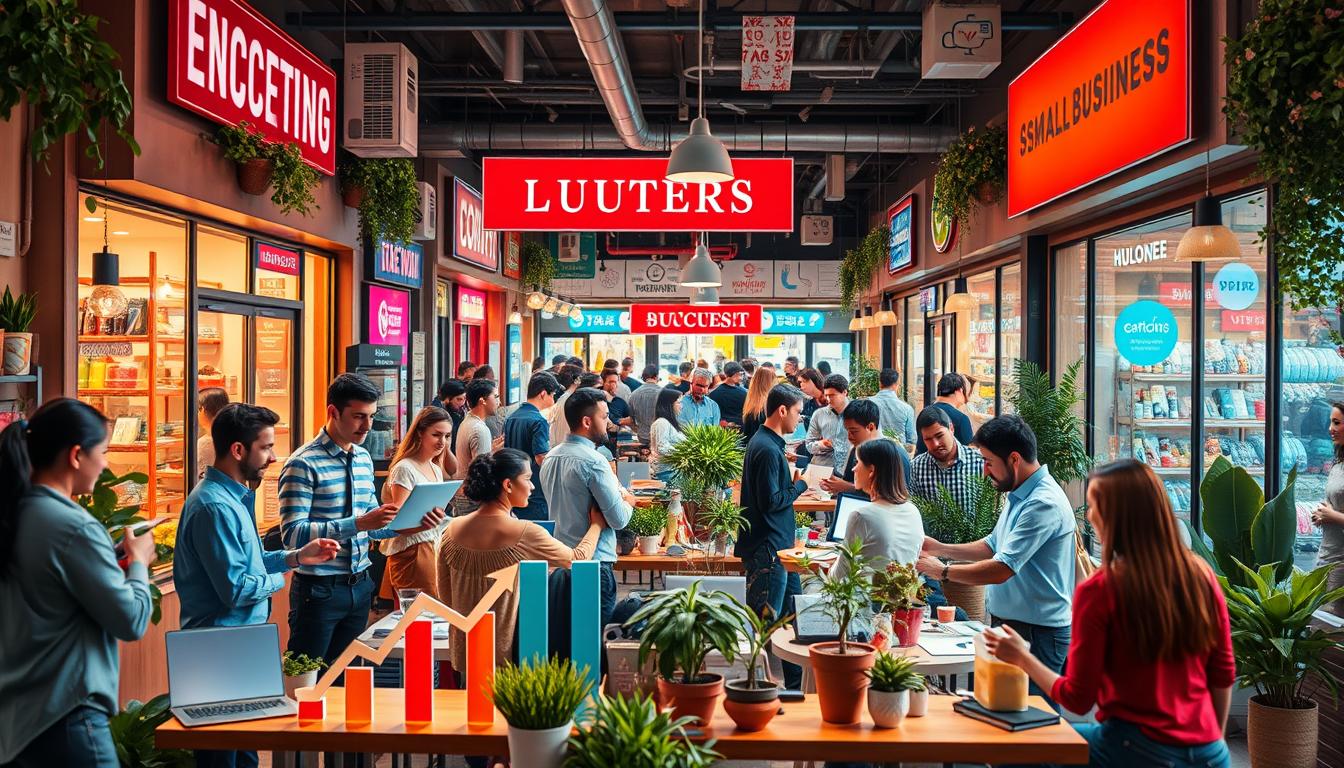The retail industry is undergoing a remarkable transformation as e-commerce continues to revolutionize the way we shop. With more and more consumers embracing online shopping, it has become essential for retailers to adapt to the changing landscape and embrace the latest e-commerce trends.
Technology plays a significant role in shaping the future of retail by enhancing the digital retail experience. From advanced artificial intelligence to sophisticated digital platforms, retailers are leveraging technology to better understand consumer behavior and provide personalized shopping experiences.
As consumer behavior in e-commerce evolves, retailers and property owners are exploring innovative strategies to stay ahead. The “click-and-mortar” approach, where online and offline shopping experiences are combined, has gained traction. Additionally, mixed-use developments that integrate residential, commercial, and public spaces are becoming popular, creating vibrant retail destinations.
While there are challenges to overcome, such as changing consumer expectations and the need for data security, the future of retail offers exciting opportunities. Micro fulfillment centers are on the rise, enabling faster order processing and delivery, while the concept of special customer experiences is redefining the retail landscape.
Key Takeaways:
- E-commerce is reshaping the retail industry and retailers must adapt to the latest trends to stay competitive.
- Technology, such as artificial intelligence and digital platforms, is driving the future of retail by enhancing the digital shopping experience.
- The “click-and-mortar” approach and mixed-use developments are innovative strategies for retailers and property owners to attract customers.
- Challenges include changing consumer behavior and the need to protect consumer data, but the future also brings exciting opportunities like micro fulfillment centers and special customer experiences.
- Adapting to e-commerce trends and prioritizing personalized customer experiences are key to thriving in the evolving retail landscape.
The Role of Technology in Shaping the Future of Retail Real Estate
Technology plays a crucial role in shaping the future of retail real estate. Advancements in technology have revolutionized the way property owners and retailers operate, allowing them to adapt to the changing landscape of e-commerce. From smart buildings and advanced sensors to artificial intelligence and digital platforms, technology is transforming the retail industry.
Smart buildings and advanced sensors enable property owners to optimize building performance and create more responsive spaces. These technologies provide valuable data that can be used to enhance energy efficiency, security, and overall tenant experience. Retailers and property owners can leverage this technology to streamline operations and reduce costs, ultimately improving the bottom line.
Artificial intelligence and machine learning have become essential tools in retail real estate. With predictive analytics and forecasting capabilities, retailers can gain insights into consumer behavior and make data-driven decisions. By understanding customer preferences and trends, retailers can tailor their offerings to meet the demands of the market, leading to increased customer satisfaction and loyalty.
Digital platforms have revolutionized the way retailers manage their businesses. From online ordering and delivery to tenant relationships and operations, digital platforms provide a seamless and efficient way to conduct business in the digital age. These platforms offer convenience for both retailers and customers, enhancing the overall shopping experience.
Augmented reality and virtual reality present exciting opportunities for the retail industry. These technologies allow customers to try on products virtually, visualize how furniture or decor would look in their homes, and explore virtual showrooms. By providing immersive and interactive experiences, retailers can engage customers in new and innovative ways, ultimately driving sales and brand loyalty.
In conclusion, technology is shaping the future of retail real estate. From smart buildings and advanced sensors to artificial intelligence and digital platforms, technology is revolutionizing the way retailers operate and engage with customers. By embracing these technological advancements, retailers and property owners can stay ahead of the competition and thrive in the evolving world of e-commerce.
How Retail Real Estate Owners and Retailers are Adapting to the Rise of E-Commerce
Retailers and real estate owners are quickly responding to the rise of e-commerce by adopting innovative strategies and embracing new technologies. With the goal of providing convenience and engaging customers, many retailers are implementing the “click-and-mortar” approach. This involves seamlessly integrating online and offline shopping experiences by leveraging the strengths of both platforms. By combining the convenience of online shopping with the sensory aspects of brick-and-mortar stores, retailers can offer customers a hybrid shopping experience that caters to their preferences.
One exciting technology that is transforming the retail industry is augmented reality (AR). By utilizing AR, retailers can create interactive experiences and virtual showrooms. Customers can use their mobile devices or specialized AR devices to visualize products in their own surroundings before making a purchase. This enhances the personalized shopping experience and allows customers to make more informed decisions, driving higher customer satisfaction and loyalty.
Retail real estate owners are also adapting to the rise of e-commerce by embracing mixed-use developments. These developments integrate residential, commercial, and public spaces, creating vibrant communities that attract a diverse range of customers. By incorporating residential units, offices, entertainment venues, and shopping destinations, property owners can generate additional revenue streams and foster a sense of community. Mixed-use developments offer a unique experience where residents can live, work, and shop all within walking distance, promoting a sustainable and convenient lifestyle.
Promoting New Business Models
Retail real estate owners and retailers are not only adapting to the rise of e-commerce but also exploring new business models to capitalize on the opportunities it presents. One such model is partnering with entertainment venues, such as cinemas or concert halls. By hosting these attractions within retail spaces, property owners can attract more customers and create a dynamic and engaging environment. Additionally, retailers are investing in subscription-based services to provide personalized and curated experiences to customers. This not only cultivates brand loyalty but also generates recurring revenue for the business.
By adapting to the changing landscape of retail, retailers and real estate owners can thrive in the digital age. It is essential for them to prioritize personalized shopping experiences and embrace innovative technologies like augmented reality. The integration of online and offline shopping through “click-and-mortar” approaches and the development of mixed-use properties create exciting opportunities for growth and revenue generation. Through these adaptations, the retail industry can continue to evolve and meet the ever-changing needs and expectations of modern consumers.

Rethinking Retail Real Estate: Strategies for Success in the Age of Online Shopping
Retailers today face the challenge of adapting to the rapidly changing landscape of online shopping. To thrive in the digital age, it is crucial for retailers to rethink their strategies and embrace innovative approaches. Here are some key strategies that can help retailers succeed in the age of online shopping:
1. Embrace an Omnichannel Approach
An omnichannel approach is essential for retailers looking to provide a seamless and personalized shopping experience. By integrating physical stores with digital channels, retailers can engage customers across different touchpoints and offer convenience, flexibility, and consistency in their shopping journey. This approach allows customers to research, browse, and make purchases online, while also providing the option to visit physical stores for a more immersive and hands-on experience.
2. Create Immersive In-Store Experiences
While online shopping offers convenience, retailers can differentiate themselves by creating immersive in-store experiences that cannot be replicated online. By leveraging technology such as augmented reality (AR) and virtual reality (VR), retailers can provide customers with interactive and engaging experiences. For example, clothing retailers can use AR technology to allow customers to virtually try on clothes, while furniture stores can use VR technology to let customers visualize how furniture will look in their homes.
3. Reduce Packaging Waste and Embrace Sustainability
Environmental consciousness is increasingly important to consumers, and retailers can appeal to this demographic by reducing packaging waste and embracing sustainability. By using eco-friendly packaging materials and exploring innovative packaging solutions, retailers can not only reduce their environmental footprint but also enhance their brand image and attract environmentally conscious consumers.
4. Harness Technology for Retail Workforce Management
Technology plays a crucial role in retail workforce management. It can help streamline operations, improve productivity, and enhance the overall customer experience. Retailers can leverage technology for tasks such as inventory management, staff scheduling, and customer relationship management. For example, workforce management software can automate scheduling processes, ensuring optimal staffing levels and reducing administrative burdens.
5. Protect Consumer Data
In the digital age, protecting consumer data is of utmost importance. Retailers must invest in robust cybersecurity measures to safeguard sensitive information and comply with data protection regulations. Building customer trust through secure data management can help retailers build long-term relationships and enhance their reputation in the market.
6. Innovative Delivery Mechanisms
In the age of online shopping, convenient and efficient delivery mechanisms can be a game-changer for retailers. Retailers should explore innovative options such as curbside pickup and micro fulfillment centers to provide customers with flexible and efficient delivery options. These mechanisms not only reduce delivery times but also cater to customers’ evolving needs and expectations.
By rethinking retail real estate and implementing these strategies, retailers can position themselves for success in the age of online shopping. Embracing an omnichannel approach, creating immersive in-store experiences, reducing packaging waste, leveraging technology for retail workforce management, protecting consumer data, and exploring innovative delivery options are key to thriving in the evolving retail landscape.
| Strategies | Benefits |
|---|---|
| Embrace an Omnichannel Approach | – Seamless and personalized shopping experience – Increased customer engagement and loyalty – Expanded customer reach |
| Create Immersive In-Store Experiences | – Differentiation from online competitors – Enhanced customer engagement and satisfaction – Increased foot traffic to physical stores |
| Reduce Packaging Waste and Embrace Sustainability | – Appeal to environmentally conscious consumers – Enhanced brand image and reputation – Reduced environmental footprint |
| Harness Technology for Retail Workforce Management | – Improved operational efficiency – Streamlined inventory management – Enhanced customer experience |
| Protect Consumer Data | – Building customer trust and loyalty – Compliance with data protection regulations – Enhanced brand reputation |
| Innovative Delivery Mechanisms | – Convenient and flexible delivery options – Reduced delivery times – Improved customer satisfaction |
The Impact of E-Commerce on Retail Real Estate: Challenges and Opportunities
The rise of e-commerce has significantly impacted retail real estate, presenting both challenges and opportunities for property owners and retailers alike. Let’s explore some of the key aspects influenced by this transformative shift:
Declining Foot Traffic and Rising Vacancy Rates
With the increasing popularity of online shopping, brick-and-mortar stores have experienced declining foot traffic. This trend has led to rising vacancy rates as traditional retailers struggle to attract customers to their physical locations.
Repurposing Retail Spaces
To combat the challenges posed by declining foot traffic and rising vacancy rates, retail real estate owners have started exploring innovative strategies to repurpose retail spaces. By adding new tenants such as coworking spaces or entertainment venues, property owners can revitalize their properties and attract a broader range of customers.
Consumer Expectations and Convenience
Consumer expectations have evolved with the growth of e-commerce. Today, customers prioritize convenience and accessibility when choosing where to shop. Retailers must adapt to these shifting expectations by offering options such as curbside pickup and same-day delivery.
Warehouse and Distribution Centers
The rapid expansion of e-commerce has created new opportunities for warehouse and distribution centers. These facilities play a crucial role in fulfilling online orders efficiently, enabling retailers to meet customer demands promptly. As a result, retail real estate owners can leverage warehouse and distribution centers as additional revenue streams.
Despite the challenges posed by declining foot traffic and rising vacancy rates, the impact of e-commerce on retail real estate also presents numerous opportunities. Through strategic adaptations, retailers and property owners can embrace the changing landscape, cater to evolving consumer expectations, and carve out a successful path in the digital age.

Key Challenges and Opportunities
| Challenges | Opportunities |
|---|---|
| Declining foot traffic | Repurposing retail spaces with new tenants |
| Rising vacancy rates | Embracing convenience and accessibility |
| Exploring partnerships with warehouse and distribution centers |
Tech and Retail Trends in 2021
The retail industry is undergoing a significant transformation, with hybrid retail models becoming increasingly prevalent. The line between brick-and-mortar stores and e-commerce platforms is blurring, as retailers embrace both physical and digital channels to reach customers. This hybrid approach allows retailers to provide a seamless shopping experience, catering to the preferences of today’s consumers.
One of the key drivers of this transformation is the adoption of technology in retail. Retailers are leveraging innovative technologies to stand out in a competitive landscape and adapt to changing consumer behaviors. By embracing technology, retailers can enhance the customer experience, personalize offerings, and engage with shoppers in new and exciting ways.
The Growth of E-Commerce
In recent years, e-commerce has experienced exponential growth, and its importance has only been amplified by the global pandemic. In 2021, e-commerce sales are expected to continue their upward trajectory, with retailers striving to meet the growing demand for online shopping.
Sustainable Packaging
Environmental sustainability has become a significant focus for both retailers and consumers. In line with this trend, retailers are increasingly adopting sustainable packaging materials and practices to reduce waste and minimize their ecological footprint. By prioritizing sustainable packaging solutions, retailers can not only meet consumer expectations but also contribute to a more environmentally friendly future.
Automation in Pricing
Automation is revolutionizing the retail industry, particularly when it comes to pricing strategies. Retailers are leveraging advanced algorithms and machine learning to optimize pricing models, ensuring competitive pricing while maximizing profitability. Automation in pricing allows retailers to respond quickly to market changes, analyze consumer behavior, and remain agile in a dynamic retail landscape.
Social Media for Retail Marketing
Social media platforms have become indispensable tools for retail marketing. Retailers are harnessing the power of social media to engage with customers, build brand awareness, and drive sales. Influencer marketing has gained immense popularity, with influencers having a significant impact on consumer purchasing decisions. By leveraging social media platforms effectively, retailers can reach a wider audience and cultivate a strong online presence.
Conclusion
The future of retail is intricately tied to e-commerce trends and the seamless integration of technology. Retail real estate owners and retailers must adapt to the evolving landscape by employing savvy strategies that enhance the digital shopping experience. Immersive in-store experiences, a reduction in packaging waste, and leveraging technology for efficient workforce management are critical areas of focus.
The impact of e-commerce presents both challenges and opportunities for retailers. By remaining agile and innovative, businesses can overcome obstacles and position themselves for success in the digital age. Embracing an omnichannel approach, which combines the best of online and offline shopping, and prioritizing personalized customer experiences are crucial for thriving in the ever-changing retail landscape.
The future of retail real estate lies in the ability to create innovative and engaging experiences for customers. It is essential for retailers to adapt to e-commerce trends and leverage technology to provide seamless, convenient, and personalized shopping experiences. By staying ahead of the curve and embracing these transformative trends, retailers can unlock their full potential and thrive in the era of digital shopping.






